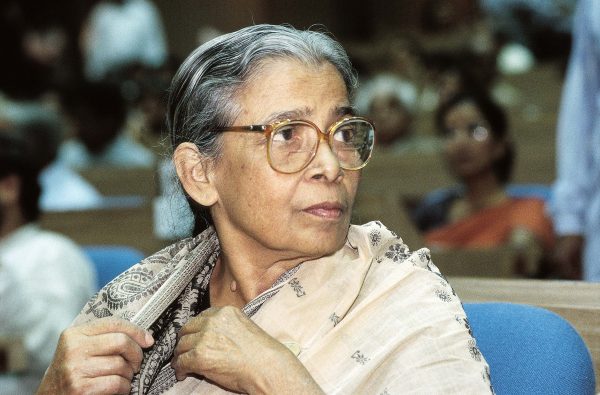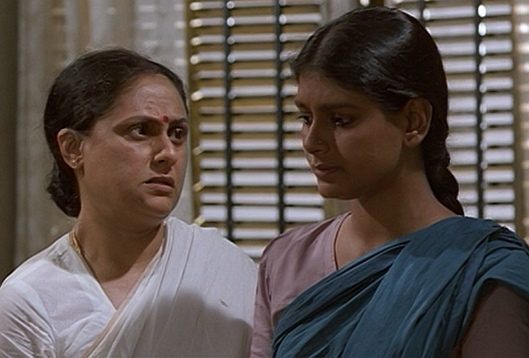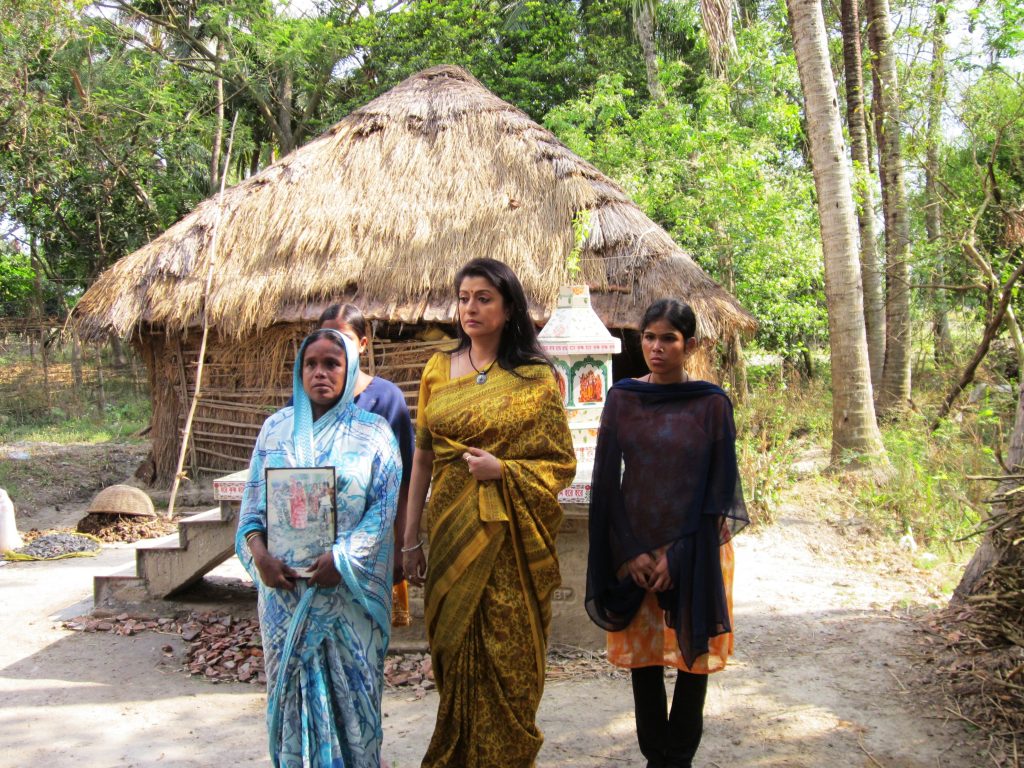Mahasweta Devi, who passed away on July 28, 2016 at the ripe old age of 90, will never have competition in literature and in social activism focussed on the tribal people of India now or in the future. She has left a heritage through her writing and her active work with her ceaseless, persisting and aggressive crusade against the oppression of the Santhals, the Hos, the Shabars, the Oraons and the Mundas and many more for a major part of her life. Her writing was fleshed out and spilled over with raw blood of the tribals. But so authentic was her writing, not only in form and content and language but also in the way she expressed the pain, the humiliation and the torture of tribals by the rest of us that it is really difficult to transpose her stories on celluloid through the medium of cinema. That is precisely why few filmmakers have dared to explore her writings to place them on film. The few who have done, directors big and small, have failed to bring out the anger, the pain, the pathos, the helplessness and the dignity that define her writings as she as if, was writing with their voices, identifying with their pain, their bloodshed and their marginalization.

Questions of ‘interpreting’ her writings for the medium of cinema, or, “questioning” her arguments, the strengths and her characters are beside the point because filmmakers might have found it impossible to relate to the things she brought out through and in her writing. Filmmakers are mainly from the mainstream though Mahasweta Devi considered the people who wrote about, lived with, learnt their language and their lifestyle and almost identified with their tragedies, considered them ‘mainstream’ and took us to be on the sidebars of humanity as it ought to be interpreted and understood.
Over the four decades, Mahashweta Devi wrote twenty published collections of short stories and close to a hundred novels, primarily in her native language of Bengali. She championed the cause of 25 million tribal people in India, who belong to approximately 150 different tribes. Her writing reflects the ugliness, squalor and misery in the lives of the tribal people and indicts Indian society for the indignity it heaps on its most oppressed constituents. Is it possible for any Indian filmmaker to represent her stories in and through the language of cinema? This writer, as she examines some of the cinematic adaptations of Mahasweta Devi’s writings, has strong reservations about it.
Unfortunately, most Indian filmmakers have converted Mahasweta Devi’s stories into lavish mainstream productions like HS Rawail did with the disappointing adaptation of Layli Asmaner Ayna, Sunghursh (1968), starring Dilip Kumar and Vyjayanthimala. Those who did not, such as Buddhadeb Dasgupta, who made two of the 13 telefilms based on two short stories by Mahasweta Devi, reduced them to cinematic rubble. These two short stories are Arjun and Choli Ke Peechey. His filmization of Arjun, about Shabars in a remote pocket trying to rescue a huge Arjun tree from being felled by two political bigwigs in the area.. The Arjuna tree not only has strong medicinal qualities but is also considered sacred among the tribals in India. In a very diabolically unconventional way, it is better than his television adaptation of Choli Ke Peeche which is so dark and so differently expressed that the very spirit of the tragedy of Gangor, the woman with voluptuous breasts is lost. Her very poor life is completely destroyed by a city-based photographer who clicks her picture and gets it published in a city paper. This destroys and ruins Gangor’s life beyond rescue. The very breasts that brought her to hog headlines are reduced to ruin just as her life is. Each of these films, done for Doordarshan, have a running time of 22 minutes, adequate if tackled with the dedication and the commitment they called for. It is very sad to discover that even an internationally acclaimed filmmaker like Buddhadeb Dasgupta could not touch even the surface of the story because he did not understand the tragedy of Gangor. Italian filmmaker Italo Spinelli’s version of the same story was turned into a full-length feature film with the title Gangor. But as it was screened only at a few film festivals and never released theatrically, it is not known how authentic his representation of Mahasweta’s shocking story was. From the reviews of this film, it appears that the focus is more on the issue of gang-rape and less on the merciless exploitation of the tribal woman by a city-based photographer. Besides, one fails to gauge that when Indian filmmakers cannot get into the soul of Mahasweta Devi’s characters and language and narration, how can an Italian filmmaker even imagine that he could come anywhere near Mahasweta’s Gangor?
In 1993, Kalpana Lajmi, after debuting with Ek Pal based on a novel by Maitreyee Devi, ventured to adapt the Mahasweta Devi story Rudaali on celluloid. She changed the backdrop from a remote area peopled by a tribal community in the fringes of West Bengal to Rajasthan, immediately investing the ambience with the lavishness of color and glamour the story did not need. The music by Bhupen Hazarika relied on melodies from his home state Assam and with one song too many, the film also became a musical. The film explores the psyche of professional mourners of Rajasthan, a vanishing breed of desperate women who sell tears for sheer sustenance. When someone important and wealthy in the village dies, these groups are summoned to mourn the death. But the real story is that their lives are so filled with personal tragedy mainly traced back to poverty and widowhood and caste ostracism that their tears dry up and they cannot cry even for money anymore. When the time comes for her to beat her chest and wave her thick mane and cry loudly, she finds she has just to draw on her storehouse of pain and personal grief to earn her livelihood when the dying landlord of the village, finally dies. Commenting on this film, the late Chidananda Dasgupta rightly stated that spectacle creates distance between the observer and the observed; the understanding of the mind of the human being in a predicament requires closeness between the observer and the observed, asking for the removal of all sights and sounds. Lajmi loses out to the lavish mounting and the musical gimmicks of commercial cinema. She ends up denying her films an identity of their own, either as films directed by a woman, or as films revolving around women. As a celluloid representation of a Mahasweta Devi story, Rudaali fails.
Mahasweta Devi created a watershed in Bengali creative fiction in general and her own writing in particular, when she wrote Hajar Churashir Ma (translated in Hindi for the film as Hazaar Chaurasi Ki Maa), in 1973. For the first time, she turned from a personalised, middle-class, auteurian setting to focus on the Naxalite movement in West Bengal. She chose as her subject, the impact of the Naxalite movement on an elitist, upper-middle-class, urban Bengali family, upon the violent death of the youngest child. Govind Nihalani who had already explored in depth, through his films Aakrosh and Aghaat, the oppression of the downtrodden and the marginalised, chose this Mahasweta Devi story to turn into a Hindi flm.
Though Nihalani’s film remains loyal to the spirit and the textual content of the story, Hazaar Chaurasi Ki Maa, the film, weaves a structure very different from the novel. The film opens with a woman stepping out of a taxi into a nursing home with a suitcase, all by herself, to deliver a baby. The camera immediately cuts into the bedroom of a middle-aged couple, with Sujata suffering from stomach cramps, reaching out to wash the mandatory pill down with the glass of water. The telephone rings, punctuating the ominous silence of the night that permeates the well-appointed house. The disoriented voice across the line asks her to come to the prison morgue to identify the body of her son. She arrives, all alone, and identifies the bullet-ridden body of Brati which has a number tagged on to a toe : 1084. She is also the lone witness and implementer of his last rites. The reaction of the rest of the family to the tragedy is totally unexpected. Her husband uses his influence and contacts to cut out Brati’s name from all media reportage about the deaths. No one mentions his name either, because a Naxalite in the family, be it the son, even after his death, invests the family name with a stigma they can do without. She invokes the family’s wrath for questioning this, in her own silent way. Sujata is haunted by memories of her son, and reinterprets what he tried to tell her so many times, now, in retrospect. The mother of the other boy (beautifully enacted by Seema Biswas) offers another shock. Though she is illiterate, poor and oppressed, unlike Sujata, she was never distanced from what her son and his friends were into. Sujata also meets Nandini, Brati’s girlfriend, who still sticks by the cause of a movement that is almost grounded by betrayals from within and torture from without. The sudden police raid of Brati’s room is yet another point of shock for Sujata. Her silent face expresses her tragic feeling of her son being killed all over again. The film meanders along, like a silent dialogue between Sujata and her dead son, through letters she pens to him every day. As Nihalani wished to invest it with a contemporary ambience, in a flash forward, we are suddenly brought to 1997, showing an aged Sujata running a documentation centre of human rights, with her mellowed husband offering her support. But there is yet another killing in broad daylight, of one of Brati’s peers in the movement, who still works with the tribals in the villages. Sujata manages to catch one of the killers while the other flees in the car they had driven in. The film ends with Sujata penning yet another letter to Brati on his birthday. The flash-forward is suddenly thrust on an unsuspecting audience that has just warmed up to the quiet, subtle voice of protest that runs like an undercurrent throughout the film. This takes away the spirit of the film which is also overshadowed by the screen persona of Jaya Bachchan though Joy Sengupta as Brati makes a marvellous debut.

And finally, Swabhoomi (2013), directed by Ujjal Chatterjee, is based on Adhoba by Mahasweta Devi. The word ‘adhoba’ means a woman who is neither a widow nor considered a married woman because her husband’s last rites have never been performed and his body remained unidentified. Saraswati (Debasree Roy) brings on celluloid the brutal story of her life where she struggles to claim her husband’s (Debesh Roy Choudhury) dead body but fails to because of governmental interference as the government is desperate to hide the intentional murder of the husband during the land-grab conflict in Shantigram in West Bengal. It is based on the real life story of Shyamali Pramanik whose husband went missing during the Nandigram killings and was discovered three months later from a ditch in the fields. Swabhoomi is unabashed mainstream masala fare. A badly executed, choreographed and positioned item number (Dimpy Mahajan) sticks out like a sore thumb. Chatterjee uses a Bangla band like a repeated metaphor but the band does not look, behave or even sing like a band and spoils the continuity of the narrative very badly. Chatterjee has filled the narrative with too many characters springing out of the woodwork without logic. No one knows who or why the police officer’s wife was shot dead. The sweet-and-syrupy ‘family portrait’ of Saraswati, her husband and the two artificial kids are dragging and melodramatic. Chatterjee has put in too many characters some of who spell out the Who’s Who of the current ruling party in West Bengal whose political affiliations have had very negative repercussions on their acting. No wonder, therefore, that the film did not face any censor trouble in the State. Chatterjee has quite transparently placed the previous government’s leading ministers in the forefront as the villains in the story.


